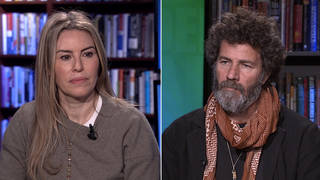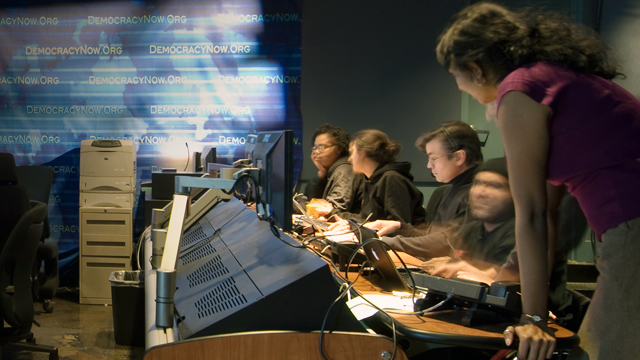
Guests
- Virginia Strom-Martinassemblymember for California’s 1st District.
- Kevin Bundythe education coordinator of EPIC, the Environmental Protection Information Center, which has been fighting the Headwaters deal.
- Julia Butterfly Hillan environmentalist who has been literally living in a tree that could now be sacrificed as a result of this settlement. She says she has no plans to come down. We talk to her via cellphone as she sits in that tree.
The California state legislature has approved a deal to purchase the Headwaters Forest. Under the $245 million bill, the world’s largest privately owned stand of ancient redwood trees will be transformed into a public preserve. But environmentalists say the settlement will only save a portion of the pristine land. What’s more, they say the deal will mean millions for Pacific Lumber Company, which owns the land. However, politicians who brokered the agreement say it is sensible. The state of California will pay $130 million to buy Pacific Lumber’s 7,500 acres of redwoods and turn it into a public park. Congress has already approved its $250 million share of the deal.
Transcript
LAURA FLANDERS: You’re listening to Democracy Now!, here on Pacifica Radio. My name is Laura Flanders, sitting in for Amy Goodman.
Now to a story we’ve been covering regularly on Democracy Now!, the discussion, the dispute, the 12-year battle, really, over the Headwaters Forest. The California state Legislature has finally approved a deal to purchase that forest. Under the $245 million bill, the world’s largest privately owned stand of ancient redwood trees will be transformed into a public preserve. But environmentalists say the settlement will sacrifice a large portion of the pristine land. What’s more, they say the deal will mean millions for Pacific Lumber Company, which owns the property. However, politicians who brokered the agreement say it’s sensible. The state of California will pay $130 million to buy Pacific Lumber’s 7,500 acres of redwoods and turn it into a public park. Congress has already approved its $250 million share of the deal.
With us on the line from California to give us some various perspectives on this plan, that was agreed Monday evening in the California Legislature, we have three guests. The first is an assemblymember representing the 1st District in California. Her name is Virginia Strom-Martin.
Virginia, first to you, before we get to the critics of the deal. Tell us what is sensible and what is an achievement in this habitat conversation — conservation plan, the Headwaters agreement.
VIRGINIA STROM-MARTIN: Well, first of all, I’d like to point out that this is a compromise. And while I was very, very critical of this deal all the way along, I believe that this at least provides us, you know, a good method of preserving the 8,500 acres forever. The Habitat Conservation Plan that goes along with this deal is going to have to be scrutinized over the months. And in fact, it’s still — there’s still a public hearing process underway for that plan. And I just believe that the consequences of us not going ahead and purchasing this property while we have the opportunity would be far worse. In fact —
LAURA FLANDERS: Let’s just —
VIRGINIA STROM-MARTIN: In fact, within three weeks, the company would actually be salvage logging the Owl Creek area.
LAURA FLANDERS: Clarify for us, if you can, the distinction between the agreement, which is the agreement to, you know, decide to give the funding to complete the purchase, and the conservation plan, which you’re saying actually hasn’t been agreed on yet.
VIRGINIA STROM-MARTIN: OK. Well, what we are purchasing here, as you had said, was 8,500 acres of ancient old-growth redwoods. Those will be within — you know, that will be public property now. That will turn into a preserve. The surrounding area, the additional acreage that surrounds the 8,500 acres, will be part of a Habitat Conservation Plan, which will include a watershed analysis assessment that has to be reviewed by the United States Fish and Wildlife Service, as well as the National Marine Fishery Service. And one of the things that I think was a plus that we got in the deal is the fact that when those two entities do review and assess those watersheds, which, of course, are very important to the survival of the coho salmon, the company no longer has veto power in terms of that assessment, so they have to go with what the feds say. So, I think that was a win for us. There will be a peer review to evaluate, on a spot-check basis, the appropriateness of those analyses and, of course, the prescriptions involved in how we are going to deal with those watersheds, that are so important.
LAURA FLANDERS: Now, we’re going to go in a minute to those who are critical of the plan from an environmentalist point of view. Tell us a bit about the debate inside the Assembly, where I’m assuming you had critics from the other side.
VIRGINIA STROM-MARTIN: Well, to be perfectly honest with you, the debate inside the Assembly had to do with the fact that we are, you know, giving Charles Hurwitz an extreme amount of money for this property. That was really the main emphasis on the debate in the Assembly.
LAURA FLANDERS: So, people who thought the Pacific Lumber Company shouldn’t be paid.
VIRGINIA STROM-MARTIN: And, you know, I have a problem with that, as well, but as I say, this was a compromise, and I did see that the company did move in the last 10 days of negotiations. Obviously, we’re getting more than we originally asked for. And on top of that, the county of Humboldt is getting $15 million to offset any job loss or — and to put that into economic development, because the county itself will be impacted by this deal.
LAURA FLANDERS: All right, well, let’s go next to Kevin Bundy, the education coordinator of EPIC, the Environmental Protection and Information Center, which has been fighting the Headwaters deal. You’ve just heard how the assemblymember laid it out, Kevin. It sounds like there was some movement, a compromise made, the best deal they could come to. What do you make of the plan?
KEVIN BUNDY: Well, it’s difficult to really determine what we make of the plan, because we haven’t seen the final language yet. The process by which this deal got cut was really so bad and so opaque from the public point of view. I mean, I was down in Sacramento. I was in the building when all this was going on, and none of the key people who were negotiating this deal would even talk to us, even though we’ve been working on the Headwaters deal for almost two years here. And probably in terms of the policy behind this deal and its implications for other conservation efforts elsewhere in the country, you know, we understand that process pretty well, but nobody really wanted to talk to us, because we didn’t — we were not in support of this agreement.
I want to just correct a couple of figures. Of the 8,500 acres that Ms. Strom-Martin is talking about, actually only about 3,500 of those acres are old-growth redwood. The rest are buffer zones. So, when you start to — buffer zones that have largely been clear cut or are second-growth areas.
And she also talks about a watershed process that supposedly was improved under this agreement, this process of going out into the watershed, taking a site-specific look at what’s going on, and then having federal agency biologists come up with plans for where the company can continue to log and where they can’t. This all sounds very good, but some language was added in the last — in the last minute, in the last couple — in the last hour of negotiations, that gives the state agency, which has permitted logging that has destroyed salmon habitat over the past 25 years up and down these coastal watersheds — the same state agency still has authority over the actual logging plans that will be done under this Habitat Conservation Plan. It’s not clear that all that pretty language about the federal agencies being able to determine what happens really means anything when the rubber meets the road and the actual logging plans get approved.
This process is very flawed, because, essentially, we’re just talking about a leverage situation that was created in the California Legislature. They just took the money hostage, until they managed to get some concessions made by the company and the federal government in the way that this federal process is going to work. It’s not a direct — the California Legislature did not direct how a certain — how things are going to be done under this federal process. They just said, “You can’t have our money until things are done this way under the federal process.” Of course, there’s no enforcement provision. If the company fails to do it, it’s not like we get our money back.
LAURA FLANDERS: I’m going to let the assemblymember come right back in a moment, but I want you to clarify one other point for us. As far as I understand it, in most habitat conservation plans, or HCPs, landowners are supposed to set aside some portion of their land as mitigation for the destruction that they’re causing on other parts of the property, and in this case, Pacific Lumber is being paid for that mitigation. Is that a dangerous precedent? Is that something you’re worried about?
KEVIN BUNDY: It’s been something we’ve been worried about all along. This is a common practice under a habitat conservation plan. Under the law, all they’re really — under the law, if a company prepares a habitat conservation plan, they can get a permit to kill endangered species and destroy their habitat in areas where that habitat would otherwise be protected. That’s a situation we’ve been looking at for several years here.
The current Pacific Lumber Habitat Conservation Plan would require them, actually, to set aside a few large chunks of old-growth redwood and residual redwood where the threatened marbled murrelet lives, and certain — if they set those aside for the life of the permit or for some unspecified time under that permit, they then get a permit to go ahead and cut down other places where the marble murrelet lives. What the timber company objected to, essentially, was that there were these set-asides at all, that they weren’t going to get paid for. And we believe they used these last-minute negotiations in order to get even more money out of the state and federal governments in exchange for their compliance with the law. It’s as if they’re saying that a private property owner does not necessarily have to obey the law, and they can just threaten to sue the state and federal governments, which they did, and get paid for it anyway.
LAURA FLANDERS: For us urban East Coast dwellers, the marbled murrelet is an animal, right?
KEVIN BUNDY: I’m sorry. It’s a threatened sea bird —
LAURA FLANDERS: OK.
KEVIN BUNDY: — that nests only in the upper limbs of old-growth coastal trees.
LAURA FLANDERS: Excuse my ignorance.
KEVIN BUNDY: That’s all right.
LAURA FLANDERS: One other person we have on the line is Julia Butterfly Hill, an environmentalist who’s been literally living in a tree, that could now be sacrificed despite this plan. It’s one of the ancient Douglas firs that’s on a steep and unstable slope of the Mattole Valley, where she’s — you’re saying you have no plans to come down from that tree, Julia Hill. We’re talking to you via cellphone. What are your plans?
JULIA BUTTERFLY HILL: Well, I have to make one correction. I’m actually — well, it’s two. I’m in an ancient redwood, and I am not in the Mattole area. I am —
LAURA FLANDERS: Oh.
JULIA BUTTERFLY HILL: — above the town of Stafford, California.
LAURA FLANDERS: Oh, so you’re not part of this group that is likely to be actually destroyed under this plan?
JULIA BUTTERFLY HILL: Yes, no, I am.
LAURA FLANDERS: OK.
JULIA BUTTERFLY HILL: I am in a spot to tell people about everything that’s wrong with the Habitat Conservation Plan. And the biggest, some of the most glaring problems with this whole plan, and with the government deciding they can compromise the way, the quality of our lives, and by compromising the quality of our environment, is that they refuse to look at the bigger picture. For instance, I’m right next to a mudslide that destroyed seven families’ homes in the town of Stafford below me on New Year’s morning of ’97. If we replace those seven homes with a stream with salmon in it with a hundred-foot buffer zone protection that is proposed under this plan, well, then Pacific Lumber is free to do what it wants, only to be answerable to the California Department of Forestry, that approved this timber harvest plan that caused the mudslide. They go, they apply for the timber harvest plan. It is approved. They cut. It causes a mudslide, and it wipes out that stream with salmon at the base of the hill. What good are those hundred-foot buffer zones then?
LAURA FLANDERS: What about the point made by the assemblymember that this was a compromise, this was the best they could come up with?
JULIA BUTTERFLY HILL: Well, I want, you know, to ask people: Why do we have politics deciding the quality of our lives? Today, it’s come to the point where, yes, there’s a lot of compromise, because it seems, more often than not, a politician’s job is to preserve politics, not the environment. For instance, that’s how a Habitat Conservation Plan came into being. The Endangered Species Act was brought into existence to protect species. The Habitat Conservation Plan was brought into existence to protect politicians and others from lawsuits being filed against them for enforcing the Endangered Species Act. Basically, what they’ve done with this deal is they’ve compromised on a compromise. What they’re doing is they’re compromising away the integrity of our forest, the integrity of critical habitat for threatened endangered species, and therefore the integrity of the quality of our lives.
LAURA FLANDERS: What did you want to see instead, after this 12-year struggle around Headwaters?
JULIA BUTTERFLY HILL: I am for land acquisition. I believe, you know — first of all, I believe in enforcing the laws already in existence. This company has violated the Forest Practices Act over 250 times in three years and has walked away with a minor slap on the wrist. If it was any one of us, we would be in prison for the rest of our lives. So, the first thing I want is for them to begin enforcing the laws that are in existence. That’s another thing missing in this deal. They have no mechanism for enforcement. And if we look at the past of Pacific Lumber, we will see the future under this deal, which is complete and total destruction.
LAURA FLANDERS: Now, you’ve seen some of the enforcement efforts by Pacific Lumber quite close to hand. Remind our listeners just where you are situated and some of the action that you’ve seen.
JULIA BUTTERFLY HILL: Well, I am in an ancient redwood above the town of Stafford, California, like I said, northern Humboldt, Northern California. And I don’t think I understand exactly your question.
LAURA FLANDERS: Well, I’m going to come back to you in just a moment. We’re going to take a break for stations to identify themselves, but I wanted for you to give our listeners something of a picture of just what happens when the companies try to come in and claim the land, that in this situation they will nonetheless be able to claim large portions of in the weeks and months to come. So, I’m going to come right back to you after 60 seconds, and also come back to the Assemblymember Virginia Strom-Martin. You’re listening to Democracy Now!, here on Pacifica Radio.
[break]
LAURA FLANDERS: You’re listening to Pacifica Radio’s Democracy Now! We’re speaking about the deal arrived at this week in the California Legislature to complete the Headwaters plan. There is controversy and dispute about whether the agreement that was arrived at this week is a great thing or a poor compromise on a compromise. We were just speaking with Julia Butterfly Hill, who’s an environmentalist who’s been living in a redwood in northern Humboldt County, above the town of Stafford. Julia, what I was going to — what I was asking you was — well, let’s put it more concretely: What do you expect to face in the next few weeks and months? And you’re not going to come down from your tree, right?
JULIA BUTTERFLY HILL: Right. I’m not sure what I’m going to face. With this company, every time we think that they’ve gone as far as they can possibly go in disrespect of not only environment, but people’s very lives, such as the families in Stafford below and others in the Mattole and Freshwater area, everywhere, other people that live in this area, they go and do something even worse. And the reason they continue doing it is because the California Department of Forestry refuses to enforce and uphold the laws that are already in existence.
During my time here, basically, the reason I’m here is because I’m right next to the mudslide. This area has shown itself to be too steep and too unstable to be cutting on. Yet Pacific Lumber applied for a timber harvest plan, and it was approved. It seems that they like to say they’re basing their decisions on best available science. But I believe that there comes a point in time when people can look with their eyes and know right from wrong. And this has nothing to do with the best available science that Pacific Lumber can buy off. This is about understanding that our Earth has to stay in balance in order to survive, and this company is destroying the balance necessary to hold the ecosystems of these forests together.
LAURA FLANDERS: All right, Virginia Strom-Martin, assemblymember of the 1st District, you’ve heard a lot of criticism. You came on saying that this was a compromise plan. How do you respond to some of the points that have been raised in this discussion?
VIRGINIA STROM-MARTIN: Well, first of all, I’d like to say to both Julia Butterfly and Kevin Bundy, I think that you probably realize that I’m with you on a lot of those criticisms of the company. I do think that the language that we do have in there about the watershed analysis being assessed by both of those two federal agencies, and the company is going to have to live with those prescriptions, is a safeguard for us. I think that the fact that we now will have public ownership of this 8,500 acres is a good thing. At least that’s not going to be going under the — you know, the chainsaws. And frankly, you know, had we not done this, you would have been seeing a lot of protesting going on, because the company would have been salvage logging within three weeks.
JULIA BUTTERFLY HILL: You’re going to see a lot of protesting —
LAURA FLANDERS: Julia Hill.
JULIA BUTTERFLY HILL: — continuing to go on. It’s not going away. We refuse to allow this issue to just go away —
VIRGINIA STROM-MARTIN: Well, that’s well and —
LAURA FLANDERS: — because if it just goes away, our forest goes away with it.
VIRGINIA STROM-MARTIN: Right. And I think that that’s probably a good thing, because, if nothing else, this deal is going to bring the Pacific Lumber Company under even more scrutiny. And I pledge to the constituents of Humboldt County that one of the things that I am going to be working on is at enforcement of the Forest Practices Act, and maybe looking at some reforms there to tighten up some of the language that has to do about cumulative impact. You know, I’m not really terribly thrilled with this, but I, you know, had to weigh both sides of this issue and do the thing that I felt was the right thing to do at the time.
*LAURA FLANDERS: Let me ask you —
VIRGINIA STROM-MARTIN: But as has been brought to your attention, this is definitely not over with.
LAURA FLANDERS: Right. Virginia, I’d like to just come back and ask you to address directly the point that Julia Butterfly made, that this whole concept of a habitation conservation plan is already a compromise on enforcing the Environmental Protection Act, that you shouldn’t even get to this point, I think, is what Julia Butterfly is saying. How do you respond to that? Why couldn’t the company be held to account to the Environmental Protection Act and not brought into this kind of compromise situation in the first place?
VIRGINIA STROM-MARTIN: Well, habitat conservation plans have already been enacted by several other companies, as well, obviously not under the same kind of scrutiny as the Pacific Lumber Company, because of, obviously, the many Forest Practice Act violations that they have had. So this is a company that is extremely controversial and needs to — their feet need to be held to the fire now. And I think this will really give us some leverage in doing so.
LAURA FLANDERS: Kevin Bundy from the education — from the Environmental Protection Information Center, EPIC, in Garberville?
KEVIN BUNDY: It’s interesting that we talk about holding this company’s feet to the fire, when actually what happened on the Senate and Assembly floors on Monday was an incredible increase in the reward that we’re paying to this company. What the company did was create a hostage situation several years ago by threatening to, as Virginia Strom-Martin says, go in and salvage log this area. This can be done under an exemption to state law that requires no environmental review. It had us all understandably worried. But in order to avoid that situation from occurring, all we’ve done, essentially, on Monday is increase the amount of ransom that we’re sending the company. And what this actually does is send a very bad message. This establishes a bad policy of paying corporations that own endangered species habitat to comply with the law, but paying them a value for their land that’s established, as if they could go in and cut down all of that land or develop that land or extract all the resources as if the law did not apply. It’s almost as if the wise use threat or the property rights advocates threat, that environmental regulation constitutes a seizure of their property, has just been vindicated entirely by the California state Legislature.
I also want to mention this. You know, we’ve talked a lot about compromise, and I understand that not everybody is happy with this deal. We actually spoke with Pacific Lumber President John Campbell shortly after the session ended on early Tuesday morning. He said he wasn’t happy with it, either. But from our perspective, biology doesn’t compromise. It can’t compromise on the short timescale that policy and procedure affect. You cannot go out and talk juvenile coho salmon into tolerating higher stream temperatures or simply getting out of the way of a mudslide. You can’t talk a sea bird that only nests in the upper limbs of old-growth trees into just going and finding someplace else to nest. You can’t put up a sign that says, “Please go to a nearby park,” when that tree is going to be slated for destruction. That is the kind of perspective we’ve been trying to bring down to the California state Legislature and to the state and federal agencies responsible for enforcing the law, is that you really cannot compromise what these creatures need to survive. And at every single point where it looked like this agreement was running into difficulty, that biology has been compromised.
LAURA FLANDERS: We’ve got about one minute left. I’ll give the last word to Julia Butterfly in her tree at north of Stafford.
JULIA BUTTERFLY HILL: Well, I’d just like to remind people that when we’re talking about private property rights, that the homes that we live in are shelter structures. The planet is our true home, and private property has no right to destroy our home. It has no right to destroy the quality of our lives. We are all intricately connected. It’s like a web of strands. And human society has come in and decided it can rip out as many strands as it wants and not weaken that web’s ability to give us life. And we have gotten to the point now, not only do we need to stop ripping out the strands, but we need to start weaving some back in, or the quality of our lives and the quality of the lives of our children who are our future — and we need to never forget them, because that’s what this is about — it will be destroyed.
LAURA FLANDERS: That’s Julia Butterfly. She’s been living in a ancient redwood in the town of Stafford, North Humboldt. We’ve also had on the line Kevin Bundy from EPIC, the Environmental Protection Information Center, in Garberville, California. And Virginia Strom-Martin has also been with us, an assemblymember for the 1st District. Thanks very much, all of you, for being with us here on Democracy Now!












Media Options